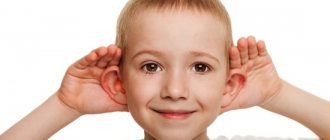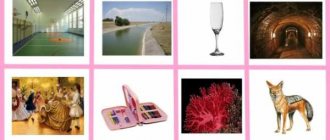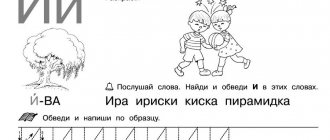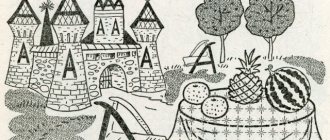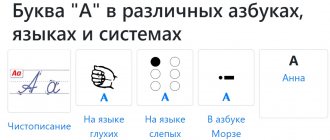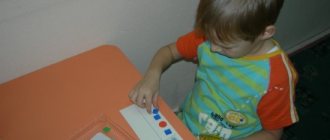Automation of sound [L]. "Naughty Kitten" | Speech therapist via Skype
Content
Sound automation game [L] “Naughty Kitten”
(based on the book by L.N. Shinkarev “Games for automation and differentiation of sounds in preschool children”)
Purpose of the game:
- Automation of sounds [ C ], [Z], [Sh], [Zh], [R], [L], [L].
- Differentiation of sounds [ C ] - [Z] - [SH] - [Zh]; [R] - [L] - [L].
- Development of the lexical and grammatical structure of speech, in particular, training in the use of case constructions
Material:
Circles made of colored cardboard, painted to look like balls
".
Pictures of balls are cut out separately and glued.
Rules of the game "Kitten - Naughty"
The balls are laid out on the table. We explain to the child that the kitten scattered grandma’s balls. To prevent grandma from being upset, they need to be collected.
You can collect the balls in any beautiful box, or place them near the grandmother sitting in the chair, shown in the story picture.
To practice distinguishing (differentiating) sounds, you can ask the child to collect balls with pictures containing different sounds (for example, the sounds [C] - [Ш] or [Р] - [Л]) in different piles or different boxes.
You can ask the question: “What pictures did you collect?”, “What picture did the kitten hide?”, training in the use of the accusative case.
On the back of the glomeruli there are object pictures that the child must name correctly.
Game application: see below
The game was prepared by:
teacher speech therapist
Lyudmila Fedirko
MDOU Kindergarten No. 1 village. Aksha
I advise you to read more on this topic
logopedrunet.ru
A set of articulation exercises
Before staging L, it is necessary to carry out a preparatory stage. It includes the preparation of the organs of articulation, the normalization of their muscle tone and the formation of the psychological basis of speech. In gymnastics for the organs of articulation, the main emphasis is on developing the elevation of the tongue.
- Basic exercise “Smile” . The preschooler is asked to smile and fix his lips in this position.
- They teach you to make your tongue narrow . The student smiles, makes his tongue narrow and tries to stretch it out as far as possible. This exercise is static.
- You also need to develop the ability to make your tongue broad . You need to smile, place your tongue on your lower lip, making it wide. This task is also static.
- The basic task for forming the rise of the tongue is “Swing” . The lips are in a smile, the narrow tongue needs to be raised and lowered.
- This list should include a basic exercise for hissing people - “Cup” . The mouth is open, the tongue is wide. It is raised so that it is shaped like a cup.
- To develop the ability to raise the back of the tongue, pronounce Y as long as possible , keeping your mouth open.
- Another task for developing tongue elevation is “Turkey” . The mouth needs to be opened slightly, a wide tongue is placed on the upper lip. Without lifting it from your lip, you need to perform forward and backward movements. First slowly, then speeding up the pace, add your voice. It should look like BL-BL (turkey popping).
- The most famous exercise is “Horse” . With the addition of vocal cords, the baby can then be encouraged to click silently.
When pronouncing L correctly, the air stream should pass through the side edges. With nasal lambdacism, you need to form the correct exhalation. The lips are fixed in a smile, the mouth is slightly open. Lightly bite the tip of your tongue with your front incisors and blow. The air stream should not pass through the center, but along the side edges.
To normalize the muscle tone of the organs of articulation, the speech therapist prescribes a special massage (for complex speech disorders) or the baby can do self-massage (patting and biting the tongue). The preparatory stage takes several lessons to form the desired articulatory pattern.
Automation of sound L
We begin automating sounds in words only after the child clearly pronounces an isolated sound and can pronounce it correctly in syllables. We name words, highlighting the automated sound with our voice.
We pronounce the words slowly, pronouncing them clearly. It is advisable to repeat the same word 2-3 times.
Articulatory posture: lips are open, it is better to stretch them into a “smile”, so that the teeth are exposed, the teeth are open, the tongue is free, spread out like a “scapula”, the tip is raised to the alveoli or necks of the upper incisors and forms a tight connection with them, the lateral edges of the tongue are lowered and form gaps with the molars through which air passes, the root of the tongue is raised.
Pronounce clearly the sound [l] in syllables, first vertically, then horizontally: la al ala lal lo ol olo lol lu ul ulu lul ly yl yly lyl
We fix the pronunciation of the sound L at the end of words:
oval glass channel collapse pencil case basement station metal capital dump truck angle prick table trunk falcon goat cauldron church football buffalo knot woodpecker Pavel ashes torch newcomer donkey chair basketball
Exercise “Listen. Remember. Repeat"
Ball - small - hall. Collapse - metal - glass. Digged - nodded - yawned. Vol - goal - count. Cauldron - goat - goldfinch. Donkey - cover - football. Torch - woodpecker - ash. He made noise - hissed - walked.
The sound L at the end of a word in a series of words
List of words: Hall, canal, glass, basement, Ball, pencil case, coral, jackal.
List of words: Table, cauldron, goat, goldfinch, Ox, donkey, football, cover.
We fix the pronunciation of the sound L at the beginning of words:
varnish shop lama lamp noodles bast weasel patch palm avalanche swallow lamp forehead crowbar dexterous boat elbow elk vine catch break chunk tray meadow moon puddle meadow Luka lawn bow splint magnifying glass bast crafty
Exercise “Listen. Remember. Repeat"
Bench - paw - lamp. Delicacy - boatman - shopkeeper. Elbow - spoon - boat. Bow - magnifying glass - puddle. Lusha - hole - ray.
The sound L at the beginning of a word in a series of words
List of words: Paws, boat, light bulb, elbow, bast shoe, swallow.
List of words: lily of the valley, bench, lamp, spoon, elk, shovel, varnish, palm.
List of words: bow, rays, moon, lawn, horse, lotus, forehead, husky.
We fix the pronunciation of the sound L in the middle of words:
saw bowl spinning top rock shark fist salad robe talent malachite beam squirrel roll jackdaw stick fork shelf needle violet hairpin pin bottle column tent shovel broom salt shaker lapdog jump rope piggy bank parcel stretcher catch weed chop grind
hair head gold milk hunger voice cold ear balloon swamp straw column cold rinse half hammer
boulder cleaver naughty sheepskin coat pigeon dove dove beluga Kaluga acorns deck
pitchfork saw vacation scarlet cute white cradle wormwood smile Exercise “Listen. Remember. Repeat"
Cases - ash - saw. Robe - salad - rock. Ear - voice - hair. Pin tents are sleds. Swamp - Volodya - breakdown. Hungry - cold - well. Smile - cobblestone - bagpipes.
The sound L in the middle of a word in a series of words
List of words: school, apple, spinning top, soap, milk, saw.
List of words: balcony, cap, needle, shelf, Violet, jackdaw and T-shirt.
Even more picture material for automating sounds on the Sound Automation page.
logopediy-dly-detey.ru
Pathology options
The distorted pronunciation of L is called lambdacism. The cause of this disorder is the incorrect position of the articulation organs during sound pronunciation. In addition, there may be substitutions of one phoneme for another - paralambdacisms. Most often, the child chooses a sound with simpler articulation. Also, L may simply be absent in speech - the baby does not distort or replace it with another phoneme.
Types of lambdacisms:
- bilabial - in speech one hears Yu instead of L due to the fact that the tongue is not raised and the child pronounces the sound using the lips;
- nasal - during articulation, the tongue touches the soft palate, so part of the air stream passes through the nose, this adds a nasal sound;
- interdental - the tip of the tongue passes between the teeth.
Types of paralambdacisms:
- replacement with iotated vowels (Ё, E, Yu, I);
- on Vy.
Most often there are replacements from L to L, because the articulation of the latter is simpler. But sometimes there is a violation of the pronunciation of soft sounds. Properly selected exercises help correct this defect.
Stories with pictures to automate the sound “L”
Stories with pictures to automate the sound “L” will help children learn to correctly say the sound in sentences and easily remember the text for retelling.
View the contents of the document “Alla and Glory.”
View the contents of the document "Squirrel and Woodpecker"
View the contents of the document "Wolf Cubs"
View the contents of the Blue Lamp document
View the contents of the document “A Doll for Lana”
View the contents of the document “The Moose and the Calf”
Viewing the contents of the document “Luntik and Mila”
Viewing the contents of a Spider-Man document
kopilkaurokov.ru
Sound table for the sound L
| Words - hints: | elephant, | needle, | shark, | t-shirt, |
| dress, | Horse, | broom, | squirrel, | |
| donkey, | Christmas tree, | wolf, | Spoon, | |
| Onion, | crocodile, | Shovel, | bee |
1. Name all the objects in order “snake”, starting with the picture with an asterisk * (elephant, needle, shark, T-shirt, squirrel, broom, horse, dress...)
2. Place a chip on each item (you can use a button or a toy - “kinder”) and first add to the named item the phrase “I got up” :
I stood on an elephant I stood on a needle I stood on a shark, etc.
3. Name objects in pairs so that a living object is paired with a non-living object. For example, an elephant has a needle, a shark has a T-shirt, etc.
(pictures are selected in pairs: living object - inanimate object).
4. Name all the objects, adding living - non-living : elephant - alive, needle - non-living, etc.
5. Name the object on which you place the chip first in the SINGULAR , then coordinate it with the numerals TWO, FIVE : one elephant, two elephants, five elephants; one needle, two needles, five needles, etc.
6. Name each item in a diminutive form, if possible:
elephant - elephant, needle - needle, etc.
7. Color living objects yellow, inanimate objects blue.
8. Show and call elephant - yellow, needle - blue, shark - yellow, etc.
9. Name what is in the upper right corner; in the lower left corner; in the lower right corner; in the top left corner; in the top row second in a row; in the bottom row third in a row; first in the second row; between, above..., under... etc. (the task can be of any complexity).
10. Come up with one sentence for each subject.
(complicated version of the task: come up with sentences using two words from the sound table, for example, elephant and needle - elephant threads a needle)
Make sure you pronounce the L sound correctly!
Author of the material: Inga Didkovskaya
Also on the topic: “Automation of sounds”
logoped18.ru
Speech therapy diagnostics
Before starting to work with a preschooler, a speech therapist conducts diagnostics to determine the speech disorder and the mechanisms of the disorder. He checks the condition of the motor sphere. Particular attention is paid to the articulatory apparatus: its anatomical features and motor skills. The child is asked to perform static and dynamic exercises.
The specialist also checks the sound-pronunciation side of speech. Diagnostics includes checking:
- pronunciation of all phonemes;
- tempo-rhythmic component;
- syllable structure.
The speech therapist begins to check sounds with isolated pronunciation, then in syllables and words. The specialist also pays attention to how the baby pronounces phonemes in normal speech. Then the speech therapist looks at the formation of phonetic-phonemic processes. Checking this block includes:
- assessment of phonemic hearing (recognition and discrimination of sound in the speech stream);
- formation of sound-letter analysis;
- working with paronymous words.
The speech therapist necessarily checks the impressive and expressive vocabulary - speech understanding, vocabulary and how he uses it in his speech. Then the formation of grammatical structure and coherent speech.
The speech therapist selects speech material for diagnosis in accordance with the child’s age. Also, parents should not worry too much if a child at the age of 3 cannot pronounce the sound L. The sonorous group is formed closer to 4-5 years, but it is worth paying special attention to the rise of the tongue.
Timely speech therapy diagnostics will identify possible problems that may cause distortion of sound pronunciation. The speech therapist will select exercises that prepare the organs of articulation for pronouncing the sound L.
Sound automation [L]
The hard consonant sound [L] is colored blue (hard consonant). Vowel sounds are colored red.
The sound [L_] is pronounced for a long time and only with a motionless tongue (see articulation of the sound [L]).
1) Pronounce (read) syllables with the sound [L_]
Sample: al__, ol__, st__, yl__, el__, il__, el__, yol__, yul__, yal__
2) Pronounce (read) words with the sound [L] at the end
Sample: floor__, y-goal__
|
|
|
|
|
3) Pronounce (read) words with the sound [l] in the middle
Sample: floor, and head
|
|
|
|
4) Pronounce (read) the syllables L__A, A__O, L__U, L__Y, L__E
5) Pronounce (read) words with the sound [L] at the beginning
Sample: l__ak, l__a-pa
|
|
|
|
|
6) Pronounce (read) words with the sound [l] in the middle
Sample: ka-l__ach, sa-l__at
|
|
|
|
7) Pronounce (read) syllables
Sample: k-l__a, k-l__o, k-l__u, k-l__y
|
|
 Pronounce (read) words with a combination of consonants with the sound [L]
Pronounce (read) words with a combination of consonants with the sound [L]
Sample: f-l__ag, p-l__a-val__
|
|
|
|
9) Pronounce (read) words with two sounds [l]
Sample: f-l__ag, p-l__a-val__
|
|
|
|
10) Pronounce (read) phrases
Sample: SAMPLE: White ha-l__at
- Blue dress.
- Bright moon.
- Bad boat.
- Yellow scarf.
- Broken saw.
- Cold basement.
- Hungry wolf.
- Thick stick.
- Heavy hammer.
- Ripe strawberries.
- A warm coat.
- A spiky tree.
- Tin soldier.
- Golden ear.
- Blue eyes.
- Silk blouse.
- Deep well.
11) Conjugate sentences
- I ate milk noodles.
- I bought a notepad and chalk.
- I broke my bike.
- I was sailing on a boat on the waves.
- I ate ripe strawberries.
Sample:
- I drank cold milk.
- You drank cold milk.
- He (she) drank cold milk.
- We drank cold milk.
- You drank cold milk.
- They drank cold milk.
12) Say (read) sentences
Sample: Mi-l__a pi-l__a mo-l__o-ko
- There was a table next to the table.
- Volodya went to the collective farm.
- Alla bought a white dress.
- Mila carried the blue flag.
- A boat floats on the waves.
- Klava clapped her hands.
- Klusha swept the floor.
- The elephant has white tusks.
- The squirrel was sitting near the hollow.
- Klava bought onions and beets.
- Mila ate strawberries from a basket.
- Nikolai broke his bike.
- Volodya forgot where he put his pencil case.
13) Pronounce (read) pure sayings
- He sat down and ate everything.
- Near the bell stake.
- Klava deftly chopped the onion.
- Mom didn’t spare soap; mom washed Mila with soap.
- The stake is near the table, the table is near the stake.
- Polkan pushed the stick with his paw.
- Alyonka sat down in the corner - Alyonka had a lot to do.
- The nightingale is not great, but its voice is golden.
- Put off idleness, but don’t put off doing things.
- A cap under a cap, a cap under a cap.
- Here the cheerful bun rolled like a ball.
- Fyokla’s beets were wet and dry.
- Slava swam on a raft and caught roaches from the raft.
14) Pronounce (read) and retell the text
Naughty
Mila had a cat. He was completely white. Mila named him Belyak. Belyak was a big naughty man. One day Mom was knitting new socks for Mila. There was a ball on the table. Mom left the room and left the ball on the table. The white hare jumps onto the chair, from the chair onto the table, and let’s push the ball with his paws. The hare pushed and pushed the ball and tangled all the threads. Mila entered the room, saw a ball on the floor and said: “Oh, what a naughty man you are, Belyak!”
15) Say (read) poems
White snow, white chalk, The white hare is also white. But the squirrel is not white, the squirrel was not white.
Grandfather planted onions and grew an onion. The grandson saw the bow and tore off the forelock of the bow.
Klava deftly chopped onions, Lala washed the floor and shelves, Volodya knocked out the dust, Valya hammered nails, Kolya merrily sawed, Anatoly washed the forks, and little Sveta ate sweet candies.
- White hare, white hare! Where did you run after the bast? The white hare answered: “I didn’t run, I galloped.”
